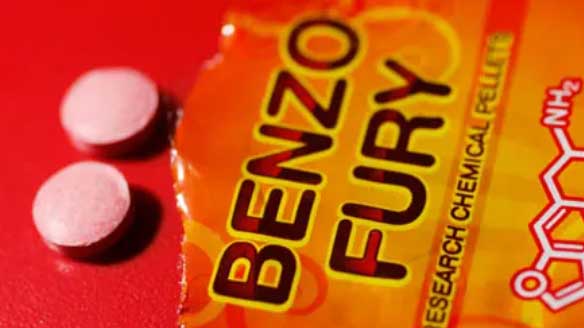Stimulant drugs are substances that speed up your central nervous system. Some are very well-known, including MDMA (also called ecstasy) and amphetamine (also called speed).
Other stimulant drugs are newer and therefore less popular.
One of these newer drugs is called 6-(2-Aminopropyl)benzofuran, or 6-APB.
What Is 6-APB?
6-APB is a synthetic drug that’s also called “benzofury,” “benzo fury,” or “white pearl.”
These names may also refer to 5-APB, a drug that’s very similar to 6-APB. Both 6-APB and 5-APB boost the amount of serotonin, norepinephrine, and dopamine in your brain. These neurotransmitters (brain chemicals) affect your mood, thoughts, and behavior.
Whether it contains 6-APB or 5-APB, benzofury is considered a new psychoactive substance (NPS). An NPS (also called a “designer drug”) is a substance designed to mimic the effects of popular illegal drugs.
Benzofury mimics the effects of MDMA and MDA. It also resembles MDA structurally. However, while MDA has a 3,4-methylenedioxyphenyl ring, benzofury has a benzofuran ring.
History Of Benzofury
Benzofury was first synthesized in 1993 by American pharmacologist David E. Nichols. Throughout the 1990s, the drug was studied as a potential antidepressant. However, studies stopped once researchers realized the drug made people feel euphoric (or “high”).
In the early 2000s, benzofury became popular at nightclubs and raves. Since then, the drug has appeared on the illegal drug market in various forms, including pills, pellets, gel capsules, and a tan grainy powder.
The powder is usually snorted or mixed in soft drinks. It can also be wrapped in cigarette papers and swallowed (a practice known as “bombing”).
In 2014, benzofury was banned in the United Kingdom. Its legal status in the United States remains unclear.
Effects Of Benzofury
Like MDMA and MDA, benzofury can have both stimulant and hallucinogenic effects, including:
- euphoria (intense joy)
- increased empathy
- emotional warmth
- increased energy
- excitement
- anxiety
- paranoia (feeling irrationally distrustful of others)
- hallucinations (seeing, hearing, or feeling things that aren’t there)
- delusions (holding beliefs that conflict with reality)
- confusion
The drug can also have physical side effects, including:
- headache
- nausea and vomiting
- trouble urinating
- chest pain
- increased heart rate, blood pressure, and body temperature
How Long Does A Benzofury High Last?
In most cases, the effects of benzofury peak around 4 hours after you take the drug.
They typically fade within 14 hours. Some people also experience a “comedown” period for a day or two after use. During the comedown, you may experience a low mood and flu-like symptoms such as fatigue, headache, and chills.
Risks Of Benzofury
Along with causing unpleasant side effects, benzofury may increase your risk of long-term health issues, including:
- dental problems
- cognitive problems, including poor memory and trouble concentrating
- liver or kidney damage
- heart attack
- stroke
More research is needed to determine whether the drug actually contributes to these issues.
Is Benzofury Addictive?
Researchers have also not yet determined whether benzofury is addictive. However, people who regularly use benzofury may develop symptoms of addiction, including cravings, tolerance, and physical dependence.
Physical dependence means your body starts relying on a drug to function normally. If you stop using it, you may experience withdrawal symptoms. Common withdrawal symptoms associated with benzofury include:
- mood swings
- anxiety
- irritability
- depression
- trouble sleeping
- reduced sex drive
- loss of appetite
- psychosis (a temporary loss of connection with reality that may include paranoia, hallucinations, and delusions)
- poor memory
- poor attention span
Most of these symptoms will fade within two weeks after your last dose of benzofury. However, psychological symptoms like depression may linger for months, especially if you don’t get professional help.
Benzofury Addiction Treatment
If you or someone you know shows symptoms of benzofury addiction, seek help at a substance abuse treatment program. Available on an inpatient or outpatient basis, these programs offer evidence-based treatments such as:
Medical Detox
During medical detox, a team of doctors will closely monitor your health as you get benzofury out of your system. They may also prescribe medications to ease certain withdrawal symptoms.
Behavioral Therapy
In behavioral therapy, a mental health professional will help you manage benzofury cravings. You can also learn how to cope with any underlying mental health concerns that may have led you to abuse benzofury in the first place.
Support Groups
When recovering from benzofury addiction, you may feel misunderstood and alone. In a support group, you can share your experiences and coping strategies with other people on the path to recovery.
Aftercare Planning
Before you leave your treatment program, your doctors can help you create an aftercare plan. This plan will include services meant to reduce your risk of relapse, such as ongoing therapy, regular exercise, and assistance with housing, education, or employment.
To learn more about drug addiction treatment options, please reach out to Northeast Addictions Treatment Center. Our board-certified healthcare providers offer comprehensive, outpatient services to help you or your loved one stay drug-free.
Keep Reading:
- This Research Chemical is Killing Users Who Think It’s LSD
- The Side Effects Of Taking Drugs
- What Is Tweaking?
- Orange Tesla Ecstasy Pills
- What Is Pink Cocaine?
- Drugs That Cause Dilated Pupils
Sources:
Journal of Applied Toxicology — Benzo fury: A new trend in the drug misuse scene
Journal of Applied Toxicology — Cytotoxic effects of psychotropic benzofuran derivatives, N-methyl-5-(2-aminopropyl)benzofuran and its N-demethylated derivative, on isolated rat hepatocytes
Progress in Neuro-Psychopharmacology & Biological Psychiatry — The effects of benzofury (5-APB) on the dopamine transporter and 5-HT2-dependent vasoconstriction in the rat




